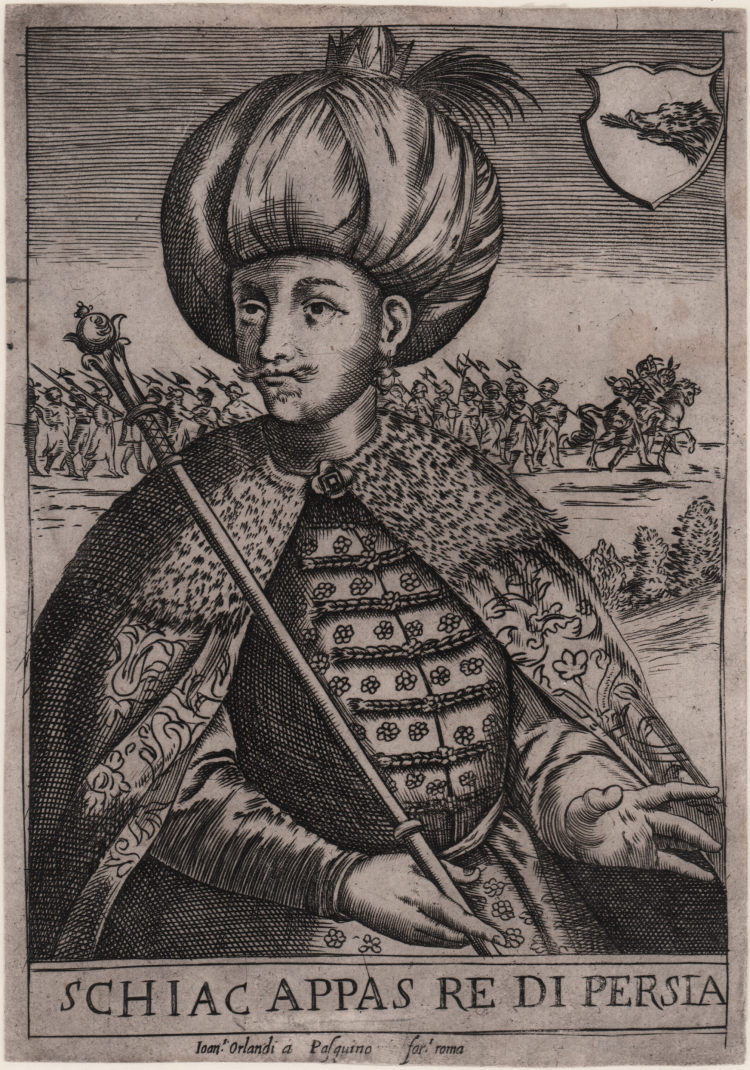



| Reference: | S32261 |
| Author | Giovanni ORLANDI |
| Year: | 1600 ca. |
| Measures: | 145 x 205 mm |


| Reference: | S32261 |
| Author | Giovanni ORLANDI |
| Year: | 1600 ca. |
| Measures: | 145 x 205 mm |
Etching and engraving, circa 1600, signed at lower right. A fine impression, printed on contemporary laid paper, with margins, good condition.
Portrait of Shah Abbas of Persia, from the Effiggie naturali de i maggior prencipi et piu valorosi capitani di questa eta con l’arme loro, a very rare suite of 58 late 16th- and early 17th-century engraved portraits of contemporary Western European, Eastern European and Ottoman sovereigns, princes, military figures, and personages, both male and female, produced in Rome by the publishers Giovanni Orlandi (fl. 1590s, d. 1640) and Andrea Vaccari (fl. from 1595, d. 1627). The engravings are an important witness to the expansion of the genre of portraiture to appeal to and capitalize on a burgeoning public interest in famous individuals in the news at the time, effectively putting faces to names of figures who were being widely discussed in popular journalistic reports. Depicted here are not only the Pope, Doge of Venice, Kings of France and Spain, etc., but also Sultan Mehmed III, Shah Abbas of Persia, Feodor I of Russia, “Prester John, King of Ethiopia” , and other living figures of interest to a European audience.
The core images of the suite – as well as the title of the suite itself – were borrowed by Orlandi from a 1596 work by the Venetian printer-publisher Giacomo Franco (1550-1620), whose Effiggie naturali consisted of 35 portraits of sovereigns and military figures active during the initial phases of what would come to be known as the Long Turkish War or Thirteen Years’ War (1593-1606), the conflict between the Habsburgs and the Ottoman Empire over the principalities of Wallachia, Transylvania and Moldavia.
Vaccari offered the prints both individually and in groups. A stock-list of the Vaccari holdings in 1614 emphasizes the ongoing, contemporary nature of this portrait suite, noting that it treated only “living” figures (“Vn libro di sessanta pezzi dell’effigie delli Capitani Illustri et Prencipi viuenti, intagliati per mano di diuersi valent’huomini,” see Ehrle, p. 64, lines 498-99).
Bibliografia
M. Bury, The Print in Italy 1550-1620; C. Pasero, “Giacomo Franco, editore, incisore e calcografo nei secoli XVI e XVII,” La Bibliofilía, vol. 37, no. 8-10 (1935), pp. 332-356.
Giovanni ORLANDI (Attivo 1590 -1640)
|
Engraver, printer and print publisher from Bologna. Active in Rome from 1590 until 1613and then in Naples. His shop in Rome was at the Pasquino. He also seems to have been a dealer in drawings. In 1608 he was employing a printer,G.B. Ranieri.
He bought existing plates from Johannes Statius, Cherubino Alberti and Nicolas van Aelst.
Orlandi acquired plates of Vignola’s Regola delli Cinque Ordini d’Architettura which he published in 1602. Orlandi does not seem to have built up a stock of plates, but having taken from them what he could, sold them on. Van Aelst bought plates from Orlandi, as for example the Twelve Profets and Ten Sibyls of Schiaminossi.
In 1609 Orlandi is reported as regretting having sold four small etched plates by Annibale Carracci, after having taken 400 impressions from them. He published work by Tempesta.
|
Giovanni ORLANDI (Attivo 1590 -1640)
|
Engraver, printer and print publisher from Bologna. Active in Rome from 1590 until 1613and then in Naples. His shop in Rome was at the Pasquino. He also seems to have been a dealer in drawings. In 1608 he was employing a printer,G.B. Ranieri.
He bought existing plates from Johannes Statius, Cherubino Alberti and Nicolas van Aelst.
Orlandi acquired plates of Vignola’s Regola delli Cinque Ordini d’Architettura which he published in 1602. Orlandi does not seem to have built up a stock of plates, but having taken from them what he could, sold them on. Van Aelst bought plates from Orlandi, as for example the Twelve Profets and Ten Sibyls of Schiaminossi.
In 1609 Orlandi is reported as regretting having sold four small etched plates by Annibale Carracci, after having taken 400 impressions from them. He published work by Tempesta.
|